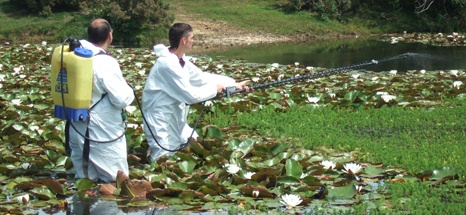 Spring has sprung, the Chelsea Flower Show is in full swing and gardeners up and down the country are heading back outside to tend their plots.
Spring has sprung, the Chelsea Flower Show is in full swing and gardeners up and down the country are heading back outside to tend their plots.
In the New Forest, this surge in interest has unforeseen consequences, as some gardeners choose to deposit their clippings and surplus plants onto the area’s sensitive habitats. This has been identified as one of the reasons why invasive non-native plants are posing a threat in the National Park.
Across the Forest, these plant invaders are cropping up in ponds, woodlands and heathland, often crowding out native species with devastating consequences.
Now experts from the New Forest Non-Native Plants Project are appealing for help from gardeners to help them tackle the area’s plant invaders. The initiative is hosted by Hampshire and Isle of Wight Wildlife Trust and funded by the New Forest Higher Level Stewardship (HLS) Scheme.
Catherine Chatters, New Forest Non Native Plants Officer, said: ‘Dumping of garden waste damages the protected habitats of the New Forest and our native species can be elbowed-out when garden plants take root and spread. Garden waste such as grass cuttings can also be a threat to commoners’ grazing animals, including New Forest ponies.
‘It is therefore very important that gardeners dispose of garden waste responsibly by composting it in their gardens, taking it to the green waste skip at their local Household Waste Recycling Centre, or using New Forest District Council’s garden waste collection scheme.’
A reduction in the amount of garden waste being dumped could reduce the number of invasive non-native species that have to be removed from the Forest each year.
Plants removed in the last year include Monbretia, which had invaded species-rich grassland as a result of garden waste being dumped near Ashurst.
Non-native garden pond plants can also become extremely invasive. In the New Forest, Parrot’s Feather was removed from wildlife-rich wetland at Hincheslea and ponds at Castle Hill and East End.
Other invasive non-native plants being removed include Japanese knotweed near Burley, Bog arum at Ipley, Cotoneaster at East Boldre and Beaulieu Heath, American skunk cabbage near Burley and Himalayan balsam along the Beaulieu River.
The HLS scheme that funds plant removal is an agreement with Natural England, held by the Verderers and managed by them in partnership with the Forestry Commission and the New Forest National Park Authority.
In addition to invasive non-native species removal, the HLS scheme also supports commoning, wetland restoration, archaeology and education. This includes bringing more than 11,000 children on school trips to the National Park, recording thousands of forgotten archaeological sites and restoring nine miles of streams to their natural meanders.
To find out more about the HLS scheme and its work to eradicate invasive non-natives species from the New Forest visit https://www.hlsnewforest.org.uk/projects/habitat-restoration-and-maintenance/invasive-plants/
-ends-
Notes to photo editors:
Parrot’s Feather at Hincheslea in the New Forest before work to control it began, credit: GBNNSS (Great Britain Non-Native Species Secretariat).